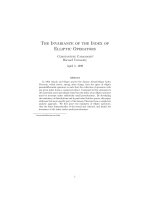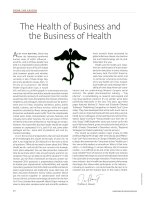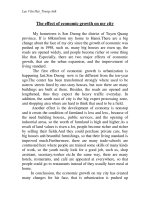Tài liệu The Effects of Equipment Age On Mission Critical Failure Rates pptx
Bạn đang xem bản rút gọn của tài liệu. Xem và tải ngay bản đầy đủ của tài liệu tại đây (1.18 MB, 125 trang )
the effects of
Equipment Age
Mission-Critical
on
Failure Rates
A Study of M1 Tanks
ERI C P ELTZ
LIS A C OLAB ELL A
BRI AN WIL LIA MS
PATRI CIA M. BO REN
Prepared for the
United States Army
R
arroyo center
Approved for public release; distribution unlimited
The RAND Corporation is a nonprofit research organization providing
objective analysis and effective solutions that address the challenges
facing the public and private sectors around the world. RAND’s
publications do not necessarily reflect the opinions of its research clients
and sponsors.
R
®
is a registered trademark.
© Copyright 2004 RAND Corporation
All rights reserved. No part of this book may be reproduced in any form
by any electronic or mechanical means (including photocopying,
recording, or information storage and retrieval) without permission in
writing from RAND.
Published 2004 by the RAND Corporation
1700 Main Street, P.O. Box 2138, Santa Monica, CA 90407-2138
1200 South Hayes Street, Arlington, VA 22202-5050
201 North Craig Street, Suite 202, Pittsburgh, PA 15213-1516
RAND URL: />To order RAND documents or to obtain additional information, contact
Distribution Services: Telephone: (310) 451-7002;
Fax: (310) 451-6915; Email:
Photo Courtesy of U.S. Army by Sgt. Derek Gaines.
Cover design by Peter Soriano
The research described in this report was sponsored by the United States
Army under Contract No. DASW01-01-C-0003.
Library of Congress Cataloging-in-Publication Data
The effects of equipment age on mission-critical failure rates : a study of M1 tanks /
Eric Peltz [et al.].
p. cm.
“MR-1789.”
Includes bibliographical references.
ISBN 0-8330-3493-6 (pbk.)
1. M1 (Tank)—Maintenance and repair. 2. United States—Armed Forces—
Operational readiness. I. Peltz, Eric, 1968–
UG446.5.E35 2004
623.7’4752—dc22
2004010090
iii
PREFACE
Due to budget limits, the service lives of many Army weapon systems
are being extended. There is a widespread belief that the resulting
increases in fleet ages are—or will be—creating readiness and cost
problems. The Army has therefore launched a program to rebuild
and selectively upgrade fielded systems, many of which currently ex-
ceed fleet age targets. This program is known as recapitalization
(RECAP).
However, initial recapitalization plans combined with investments in
new equipment have strained the Army budget, and complete
RECAP of current aged fleets has been found unaffordable. Thus, the
Office of the Deputy Chief of Staff, G-8 (Programs), the Office of the
Deputy Chief of Staff, G-3 (Operations and Plans), the Office of the
Deputy Chief of Staff, G-4 (Logistics), the Office of the Assistant Sec-
retary of the Army for Acquisition, Logistics, and Technology
(OASA[ALT]), and the Army Materiel Command (AMC) have been ex-
amining which systems (both type and portion of the fleet) should be
recapitalized and defining what that renewal process should involve
(the extent of work for each “overhaul”). Accordingly, OASA(ALT) is
sponsoring RAND Arroyo Center research on how equipment age
affects readiness and resource requirements, to aid analyses in
support of RECAP decisions.
This report describes one component of this study: an assessment of
the relationship between tank age and the mission-critical failure
rate for the M1 Abrams tank. Findings should be of interest to re-
source planners, logistics analysts, and weapon system analysts.
iv The Effects of Equipment Age on Mission-Critical Failure Rates
This research has been conducted in the Military Logistics Program
of RAND Arroyo Center, a federally funded research and develop-
ment center sponsored by the United States Army.
For more information on RAND Arroyo Center, contact the
Director of Operations (telephone 310-393-0411, extension 6419;
FAX 310-451-6952; e-mail ), or visit the
Arroyo Center’s Web site at />v
CONTENTS
Preface iii
Figures vii
Tables xi
Summary xiii
Acknowledgments xxi
Glossary xxiii
Chapter One
INTRODUCTION 1
Chapter Two
METHODOLOGY 9
Data Sources 9
Sample Characteristics 9
Measures 11
Tank Study Variables 11
System Failures 11
Age 14
Accumulated Usage During the Study Period 17
Updays 17
Location 18
Subsystem Study Variables 18
Data Refinement Techniques 19
Exclusion of Observations 19
Imputation 19
Analyses 22
vi The Effects of Equipment Age on Mission-Critical Failure Rates
Tank Study Analysis 22
Subsystem Study Analysis 24
Chapter Three
RESULTS 27
Tank Study Results 27
Subsystem Study Results 30
Interpretation of Subsystem Results 40
Rebuild Versus Upgrade Candidates 47
The Link Between Age-Failure Relationships and Part
Prices 48
Sensitivity Analysis Results 52
Alternative Imputation Approach 52
Additional Control Variable for Odometer Resets 58
Alternative Regression Techniques in the Tank Study 59
Alternative Regression Techniques in the Subsystem
Study 60
Chapter Four
IMPLICATIONS 69
Appendix
A. GENERAL DESCRIPTIONS OF STATISTICS USED 73
B. DISTRIBUTION OF FAILURE DATA 77
C. CROSS-VALIDATION OF TANK STUDY MODEL 83
D. PLOTS OF SUBSYSTEMS’ PREDICTED MEAN FAILURES
BY AGE AND USAGE 87
Bibliography 97
vii
FIGURES
1.1. Hazard Functions with Pronounced Wear-out
Regions 3
1.2. Hazard Functions Without Pronounced Wear-out
Regions 4
2.1. Number of Months of Usage Data per Tank by
Location 12
2.2. Distribution of Tank Age by Location 12
2.3. M1A1 Age Histogram 13
2.4. M1A2 Age Histogram 13
2.5. Distribution of Tank Usage by Location 14
2.6. Distribution of Initial M1A1 Odometer Readings by
Age 16
2.7. Distribution of Initial M1A2 Odometer Readings by
Age 16
3.1. Predicted Mean Failures (over 180 days) by Tank Age . 29
3.2. Predicted Mean Failures by Age at Location 1,
with 95 percent Confidence Bars (180 days, usage =
375 km) 29
3.3. Predicted Mean Failures (over 180 days) by Tank
Usage 30
3.4. Predicted Mean Failures of Second-Tier Subsystems
by Age (Location 1, 180 days) 41
3.5. Predicted Mean Fire Control Failures by Age for the
M1A1s, M1A2s, and Combination of M1A1s and
M1A2s (Location 1, 180 days) 43
3.6. Predicted Mean Failures of Second-tier Subsystems
by Usage (Location 1, 180 days) 45
viii The Effects of Equipment Age on Mission-Critical Failure Rates
3.7. Total Parts Demand (during Study Period)
per Subsystem by Age 46
3.8. Parts Demand per Part Type by Age 47
3.9. Predicted Mean Part Failures Versus Tank Age
(Location 1, 180 days) 52
3.10. Predicted Mean Failures by Age for Hydraulic and
Power Train Subsystems, Based on Multiple
Imputation Models (Location 1, 180 days) 57
3.11. Predicted Mean Failures by Usage for Hydraulic and
Power Train Subsystems, Based on Multiple
Imputation Models (Location 1, 180 days) 57
3.12. Confidence Interval Width by Age for Multiple
Imputation and Mean Imputation Overall Tank Study
Model 59
3.13. GAM Predicted Mean Failures of Chassis, Fire
Control, Hardware, and Power Train Subsystems by
Age (Location 1, 180 days) 63
3.14. 95 Percent Confidence Bands for Power Train GAM
Curve 63
3.15. 95 Percent Confidence Bands for Chassis GAM
Curve 64
3.16. 95 Percent Confidence Bands for Fire Control
GAM Curve 64
3.17. 95 Percent Confidence Bands for Power Train GAM
Curve, with Extrapolation Past Age 15 65
3.18. 95 Percent Confidence Bands for Chassis GAM Curve,
with Extrapolation Past Age 1 65
3.19. 95 Percent Confidence Bands for Fire Control GAM
Curve, with Extrapolation Past Age 15 66
3.20. Alternate Plot of Predicted Mean Failures of Second-
tier Subsystems by Age (Location 1, 180 days) 66
B.1. Illustration of Failure Data Overdispersion 77
B.2. Comparison of Battalion Failure Distributions and
Poisson Distribution in 1st Cavalry Division 79
B.3. Comparison of Battalion Failure Distributions and
Poisson Distribution in 4th Infantry Division 79
B.4. Comparison of Battalion Failure Distributions and
Poisson Distribution in 1st Infantry and 1st Armor
Divisions: Fort Riley 80
Figures ix
B.5. Comparison of Battalion Failure Distributions and
Poisson Distribution in 2nd Infantry Division 80
B.6. Comparison of Battalion Failure Distributions and
Poisson Distribution in 3rd Infantry Division 81
B.7. Comparison of Battalion Failure Distributions and
Poisson Distribution in 1st Infantry and 1st Armor
Divisions: Europe 82
D.1. Predicted Mean Hull Failures by Tank Age 88
D.2. Predicted Mean Hull Failures by Tank Usage 88
D.3. Predicted Mean Chassis Failures by Tank Age 89
D.4. Predicted Mean Chassis Failures by Tank Usage 89
D.5. Predicted Mean Power Train Failures by Tank Age 90
D.6. Predicted Mean Power Train Failures by Tank Usage . 90
D.7. Predicted Mean Turret Failures by Tank Age 91
D.8. Predicted Mean Turret Failures by Tank Usage 91
D.9. Predicted Mean Gun Failures by Tank Age 92
D.10. Predicted Mean Gun Failures by Tank Usage 92
D.11. Predicted Mean Fire Control Failures by Tank Age 93
D.12. Predicted Mean Fire Control Failures by Tank Usage . 93
D.13. Predicted Mean Electrical Failures by Tank Age 94
D.14. Predicted Mean Electrical Failures by Tank Usage 94
D.15. Predicted Mean Hardware Failures by Tank Age 95
D.16. Predicted Mean Hardware Failures by Tank Usage 95
D.17. Predicted Mean Hydraulic Failures by Tank Age 96
D.18. Predicted Mean Hydraulic Failures by Tank Usage 96
xi
TABLES
2.1. Number of M1 Tanks in Sample by Location and
Division 10
3.1. Negative Binomial Regression of Tank Failures on
Age, Usage, and Location Variables (N = 1,567) 28
3.2. Summary of Subsystem Age and Usage Effects
(Terms in Final Model) 31
3.3. Negative Binomial Regression of Hull Failures on
Age, Usage, and Location Variables (N = 1,480) 32
3.4. Negative Binomial Regression of Turret Failures on
Age, Usage, and Location Variables (N = 1,480) 33
3.5. Negative Binomial Regression of Chassis Failures on
Age, Usage, and Location Variables (N = 1,480) 34
3.6. Negative Binomial Regression of Electrical Failures on
Age, Usage, and Location Variables (N = 1,480) 35
3.7. Negative Binomial Regression of Fire Control Failures
on Age, Usage, and Location Variables (N = 1,480) 36
3.8. Negative Binomial Regression of Hardware Failures
on Age, Usage, and Location Variables (N = 1,480) 37
3.9. Negative Binomial Regression of Power Train Failures
on Age, Usage, and Location Variables (N = 1,480) 38
3.10. Negative Binomial Regression of Hydraulic Failures
on Age, Usage, and Location Variables (N = 1,480) 39
3.11. Negative Binomial Regression of Gun Failures on
Age, Usage, and Location Variables (N = 1,480) 40
3.12. Negative Binomial Regression of Low-Priced Part
Failures on Age, Usage, and Location Variables
(N = 1,480) 48
xii The Effects of Equipment Age on Mission-Critical Failure Rates
3.13. Negative Binomial Regression of Medium-Priced
Part Failures on Age, Usage, and Location Variables
(N = 1,480) 49
3.14. Negative Binomial Regression of High-Priced
Part Failures on Age, Usage, and Location Variables
(N = 1,480) 50
3.15. Negative Binomial Regression of Very-High-Priced
Part Failures on Age, Usage, and Location Variables
(N = 1,480) 51
3.16. Negative Binomial Regression of Hull Failures on
Age, Usage, and Location Variables (N = 1,480), with
Multiple Imputation Approach 54
3.17. Negative Binomial Regression of Power Train Failures
on Age, Usage, and Location Variables (N = 1,480),
with Multiple Imputation Approach 55
3.18. Negative Binomial Regression of Hydraulic Failures
on Age, Usage, and Location Variables (N = 1,480),
with Multiple Imputation Approach 56
C.1. PRESS Statistics for Models in Cross-Validation
Study 85
xiii
SUMMARY
Without a significant effort to increase resources devoted to
recapitalization of weapon systems, the force structure will not
only continue to age but, perhaps more significantly, become
operationally and technologically obsolete.
Quadrennial Defense Review Report, 2001, p. 47
Aging equipment has become a key concern of Army leaders striving
to maintain high operational readiness. Army leaders anticipate that
equipment age will pose a continually increasing challenge over the
lengthy period in which current equipment is expected to remain in
the Army’s fleet, anticipated until about 2030 in some cases, as it de-
velops and fully fields its next generation of forces termed the future
force. In response, the Army has initiated a recapitalization (RECAP)
program to rebuild and/or upgrade selected systems, such that com-
bat capabilities are maintained and maintenance costs are kept af-
fordable.
1
To date, the Army plans to rebuild or upgrade 17 sys-
tems—including the M1 Abrams, M2 Bradley Fighting Vehicle, M88
Recovery Vehicle, and other systems that are expected to remain in
the inventory for the next 15 to 20 years (Brownlee and Keane, 2002;
Army Recapitalization Management, 2003). These modernization
plans continue to evolve, however. To help determine the scale of
______________
1
Rebuilding consists of efforts to restore a system to like-new condition. Upgrading is
adding components (or replacing old components with new ones) that increase a
system’s warfighting capability (Gourley, 2001).
xiv The Effects of Equipment Age on Mission-Critical Failure Rates
RECAP required to maintain the desired level of operational readi-
ness capability, and to facilitate RECAP program design, statistical
analyses of the relationship between age and Army equipment fail-
ures are needed.
This report describes a RAND Arroyo Center study, sponsored by the
Office of the Assistant Secretary of the Army for Acquisition, Logis-
tics, and Technology (OASA[ALT]), on the impact of age on the M1
Abrams mission-critical failure rate. The M1 Abrams is of particular
interest because it is often considered the centerpiece of the Army’s
heavy ground forces, because it has a high average fleet age that will
continue to advance, and because it is scheduled to remain a key
part of the force for as many as 30 more years. Consequently, it has
been one of the key systems being targeted by the RECAP program.
RESEARCH QUESTIONS
The four research questions in this study are as follows:
1. What is the relationship between age and the M1 Abrams
mission-critical failure rate?
2
2. How is the M1 failure rate related to other factors, such as usage
and location-specific factors?
3. If there is a significant relationship between age and the M1
Abrams mission-critical failure rate, which of the various M1
subsystems and individual parts generate this relationship, and
to what degree do they do so?
4. How can statistical models of such relationships inform RECAP
decisions and planning?
Subsequent studies will address the same questions for other critical
Army ground systems.
______________
2
A mission-critical failure is defined in this study as one that makes an item not
mission capable, as indicated by the item’s technical manual and subsequently
reported by its owning unit. Mission-critical failures are also called deadlining events.
Summary xv
STUDY DESIGN
To address the research questions, we conducted two “substudies” at
the individual tank level of analysis. In substudy 1 (the Tank Study)
we assessed the impact of age, location, and usage on individual tank
failures. In substudy 2 (the Subsystem Study) we assessed the impact
of tank age, location, and usage on tank subsystem failures. Sub-
systems included actual subsystems, such as fire control, as well as
part technology groups, such as basic hardware. As an additional
segment of the Subsystem Study, we assessed the impact of tank age,
location, and usage on tank part failures, where parts (subsystem
components such as transmissions and pumps) were placed into
price categories ranging from low to very high. The samples for the
two substudies included 1,567 tanks and 1,480 tanks, respectively,
3
which includes the tanks in the Army’s six active heavy divisions dis-
tributed across what we categorized as six different geographic areas:
Germany, Georgia, Korea, Kansas, Colorado, and Texas.
The age, location, usage, and failure data came from Army mainte-
nance database extracts from April 1999 through January 2001.
4
Our
primary analytical techniques included imputation of missing data
and negative binomial regression. It should be noted that data on the
maintenance history of each tank prior to the beginning of the study
period were not available. Hence, only the ages of the tanks them-
selves, and not their components, were known.
RESULTS
The study provides preliminary support for the hypothesis that age is
a significant predictor of M1 failures, as are usage and location. The
models suggest that M1 age has a positive log-linear effect that is
consistent with a 5 ± 2 percent increase in tank failures per year of
age. For a given location, usage, and time period, this equates to a 14-
______________
3
The sample in the Subsystem Study included fewer tanks because we lacked
complete data on 4th Infantry Division M1A2 subsystem failures.
4
Failure data came from Standard Army Maintenance System-2 (SAMS-2) aho01i and
aho02i files archived in the Integrated Logistics Analysis Program (ILAP), and age,
location, and usage data come from The Army Maintenance Management System
(TAMMS) Equipment Database (TEDB). Unit price data for tank parts came from
Federal Logistics (FedLog) database extracts for January 2003.
xvi The Effects of Equipment Age on Mission-Critical Failure Rates
year-old tank having about double the expected failures of a new
tank. This conclusion only applies to the first 14 years of a tank’s life,
since most tanks in the study were 14 years old or younger at the
time of the study. (Only two tanks in the dataset were 15 years old.)
The conclusion may or may not hold beyond that point; this can be
determined as the Army’s tank fleet continues to age. In the mean-
time, it is risky to assume that this compound annual growth rate in
failures applies beyond the age range of our dataset.
Usage appears to have a log-quadratic effect on the mean failures of
tanks; this implies that as tank usage during a year increases, the
expected failures increase, but the rate of increase continually slows
as usage increases (in the range of peacetime, home-station usage).
Again, this conclusion is only valid within the range of the data—up
to approximately 3,000 kilometers in peacetime operations. At some
point the usage effect may become linear, with each one-kilometer
increase in usage producing the same increase in expected failures.
The magnitude and shape of the observed effects—particularly the
relationship between age and failures—differ across tank sub-
systems. The electrical, hardware, hydraulic, and main gun sub-
systems experienced larger absolute failure rate increases due to
aging than the chassis, power train, and fire control subsystems. The
chassis, hardware, hydraulic, and main gun subsystems experienced
the greatest relative increases due to aging. Because the electrical
subsystem had a high initial (age-0) failure rate, the relative increase
in its failure rate was low, despite a high absolute increase. Because
the chassis subsystem had a low initial failure rate, the relative in-
crease in its failure rate was high, despite a low absolute increase.
Also, for some subsystems the effect of age diminished or disap-
peared after tanks reached a certain age, which is probably an indi-
cation that the age was beyond the normal wear point for the sub-
system’s components. The point at which failures no longer increase
with age for a subsystem (or part) or actually start to decrease reflects
that point at which the peak wearout age region has been passed and
sufficient fleet renewal for the subsystem (or part) has occurred to
reduce the effective age of the fleet with respect to that subsystem (or
part).
For the fire control subsystem, our data suggest an aging effect but
also a possible effect with respect to tank variant. (Fully isolating
Summary xvii
these two effects was not possible, since age and tank variant are
confounded.) M1A2s, which are younger than M1A1s, have different
types of fire control components than M1A1s—in particular, digital
electronic line replaceable units (LRUs), rather than analog LRUs.
The data suggest that the like-new failure rate of M1A2 fire control
components is higher than that of fire control components in rela-
tively young M1A1s.
Supplementary analyses of subsystem part failures and the unit
prices of those parts provided additional information about the
drivers of aging effects. Specifically, aging effects tended to be
stronger for low-priced parts than for high-priced parts.
Although not a focus of this study, the effect of location is notewor-
thy. Some locations had significantly more tank failures than did
others, after controlling for usage and age. This could be due to dif-
ferent maintenance practices, climate, terrain, training plans, and
failure-reporting practices.
IMPLICATIONS
Consistent with private industry fleet management principles, Army
leaders have long believed that older tanks have higher failure rates
than newer ones, which increases maintenance demands and
stresses operational readiness. However, supporting statistical evi-
dence has been lacking. This study provides such evidence, demon-
strating that increasing age, after accounting for usage and location
effects, tends to raise M1 failure rates (given the current Army main-
tenance regime). Although the study is cross-sectional (incorporating
one year of data from tanks), its findings—and the results of sensitiv-
ity analyses involving additional data and tests—provide initial
quantitative support for several conclusions. Specifically, it is rea-
sonable to conclude that, without modernization, time (or age) will
pose a threat to operational readiness and increase the demand on
resources.
Another important finding is that age is harder on some subsystems
than on others. Moreover, within subsystems, age has different ef-
fects on different components. Knowledge of these patterns may
help RECAP planners determine which subsystems and components
should be rebuilt and which should receive higher priority in such ef-
xviii The Effects of Equipment Age on Mission-Critical Failure Rates
forts. Further, the study indicates which subsystems and compo-
nents are likely to drive the failure rate of new tanks—specifically, fire
control, electrical, and power train; whether new or old, these com-
ponents constitute reliability “problems.” This information suggests
where upgrade initiatives such as engineering redesign might have
the biggest impact.
Further exploration of the source of age effects on the Abrams failure
rate yields valuable insights into the aging problem. Much of the age
effect tends to result from what are, in the Abrams, relatively low-
cost components, so the age effect on operations and maintenance
cost (the budget account used to pay for spare parts) is likely to be
less than its effect on readiness and workload. These components are
typically simple parts that have dominant failure modes associated
with wear-and-tear. The expensive parts, in contrast, tend to be more
complex, with many different failure modes. Increased component
failures increase the maintenance workload burden. Since Army
maintainers are not paid according to the amount of maintenance
they perform and do not receive overtime, this does not affect the
Army’s cost structure. Rather, it can affect maintainer quality of life
when the workload necessary to maintain operational readiness
increases substantially.
Additionally, there are potential implications for force structure and
future operational readiness. Once tank age reaches a certain point,
the maintenance system may no longer be able to supply a satisfac-
tory level of operational readiness—even with workarounds such as
controlled exchange, necessitating replacement or substantial re-
build or acceptance of lower readiness possibly combined with in-
creased maintenance capacity. There is some indication that a por-
tion of the active Army’s tank fleet has already reached this point,
causing isolated M1A1 operational readiness problems. For example,
Fort Riley units, with the oldest tanks in the Army’s active inventory,
are the only active units that consistently struggle to meet the Army’s
operational readiness rate goal for tanks.
5
At the Army’s National
Training Center (NTC), tank battalions employing relatively old
M1A1s (both NTC-owned and from home stations) averaged just 74
______________
5
From 1999 to 2001, Fort Riley M1A1 operational readiness averaged 88.05 percent,
while the active force M1A1 average was 90.75 percent, based on monthly readiness
reports extracted from the Logistics Information Database.
Summary xix
percent operational readiness over the course of rotational training
events from fiscal years 1999 through 2001; 4 of the 22 battalions for
which data are available achieved less than 70 percent, a figure often
considered the breakpoint for combat effectiveness.
6
This contrasts
with an average of 83 percent for battalions with relatively new
M1A2s. Repair time for the two groups was similar, with a difference
in failure rates accounting for the difference in operational readiness
rate. Thus, for the Abrams fleet, age most likely produces gradual
workload increases, possibly resulting in decreasing soldier quality of
life and declining operational readiness, and it generates a buildup of
deferred financial cost that emerges in the form of programs such as
RECAP.
______________
6
The NTC metrics are based on manually collected data provided by NTC observer-
controllers (OC) to one of the authors. Each day, OCs collocated with tank platoons
report the operational readiness status and failure information to the Forward Support
Battalion Support Operations Officer OC, who records the information.
xxi
ACKNOWLEDGMENTS
We thank the Honorable Paul J. Hoeper, then Assistant Secretary of
the Army for Acquisition, Logistics, and Technology (ASA[ALT]), and
his staff for sponsoring this research. Within the Office of the
ASA(ALT), Dr. Walter Morrison, Director for Research and Laboratory
Management, championed the project, and his action officers, ini-
tially Suzanne Kirchoff and then Joseph Flesch, have assisted in co-
ordinating with Army organizations.
The sponsorship and strong support of another RAND Arroyo Center
project, “Diagnosing Equipment Serviceability,” by MG (ret.) Charles
Cannon, as the Army’s acting Deputy Chief of Staff for Logistics, and
LTG Charles Mahan, first as the Chief of Staff of the Army Materiel
Command and later as the Army’s Deputy Chief of Staff, G-4, made
this research possible. The equipment serviceability project led to
the ability to archive individual tank failures, which was the key
missing element for enabling this type of research for the Army. Tom
Edwards, Deputy to the Commanding General at the Army’s Com-
bined Arms Support Command (CASCOM), has also provided strong
support for this work. Within the office of the Army G-4, Donna
Shands, Associate Director for Sustainment, Kathleen Schulin, Chief
of the Retail Supply Policy Division, MAJ Diane Del Rosso, MAJ John
Collie, and MAJ Michael Kerzie played key roles in moving the
equipment serviceability research forward, as did Jan Smith and CW4
Robert Vachon of CASCOM, CW5 Jonathon Keech and CPT Doug
Pietrowski of the Ordnance Center and School, and CW3 David Car-
don of the 1st Cavalry Division.
xxii The Effects of Equipment Age on Mission-Critical Failure Rates
We are grateful to Sharon Gilbert, Karen Weston, and Donita Wright
at the Army Materiel Command Logistics Support Agency for provid-
ing database extracts of tank year-of-manufacture and usage. We
thank Theresa Ho and Mike Hilsinger at CALIBRE Systems for provid-
ing Standard Army Maintenance System-2 archives from which we
extracted tank failure information.
At RAND, the contributions of John Dumond, Rick Eden, Ron Fricker,
Bonnie Ghosh-Dastidar, Sally Morton, Tim Ramey, and Marc Rob-
bins greatly facilitated this study and its documentation. Dan Relles
and Ray Pyles provided thorough technical reviews that helped us
improve the quality of the research. We also very much appreciate
the editorial comments of Nikki Shacklett and the assistance of
Pamela Thompson and Joan Myers in preparing the document.
xxiii
GLOSSARY
1AD 1st Armor Division
1CAV 1st Cavalry Division
2ID 2nd Infantry Division
3ID 3rd Infantry Division
4ID 4th Infantry Division
AGREE Advisory Group on Reliability of Electronic
Equipment
AMC Army Materiel Command
AMSAA Army Materiel Systems Analysis Activity
ANOVA Analysis of Variance
ASA(ALT) Assistant Secretary of the Army for Acquisition,
Logistics, and Technology
CASCOM Combined Arms Support Command
DoD Department of Defense
EDA Equipment Downtime Analyzer
FedLog Federal Logistics
GAM Generalized Additive Models
LRUs Line Replaceable Units
NTC National Training Center
xxiv The Effects of Equipment Age on Mission-Critical Failure Rates
OASA(ALT) Office of the Assistant Secretary of the Army for
Acquisition, Logistics, and Technology
OLS Ordinary Least Squares
OR Operational Readiness
PRESS Predicted Residual Sum of Squares
RAM Reliability, Availability, and Maintainability
RCM Reliability-Centered Maintenance
RECAP Recapitalization
SAMS-2 Standard Army Maintenance System-2
TAMMS The Army Maintenance Management System
TEDB TAMMS Equipment Database
YOM Year of Manufacture
1
Chapter One
INTRODUCTION
Equipment reliability has become a high priority of managers in both
the private and public sectors. The term has multiple definitions, but
the most widespread one is the probability of performing an in-
tended function, for a given interval, under prescribed conditions
(Hillier and Lieberman, 1986; Omdahl, 1988; Stevenson, 1993; Morris
et al., 1995). Consequences of poor reliability, manifested as high
failure rates, can range from minor inconvenience to catastrophe.
They include financial costs, essential function or mission-capability
losses, and safety consequences. In the Armed Forces, where weapon
systems are technology-intensive and used under life-threatening
conditions, equipment failure can have particularly severe penalties
(Alexander, 1988). Many believe that the age of equipment con-
tributes to failures (Gansler, 1999; United States General Accounting
Office, 2001), and with budget constraints forcing longer equipment
life cycles, Army officials suspect that aging systems are impairing
readiness and increasing financial costs. However, the effects of age
on Army equipment have not been quantified and are therefore
poorly understood. Accordingly, this study begins an investigation,
conducted by RAND Arroyo Center, to assess the impact of age on
weapon system failure rates and the resulting consequences. The
focal weapon systems are U.S. Army ground equipment.
Interest in the age-reliability relationship has grown steadily over the
past century. Prior to World War II, the simplicity of equipment
made repairs straightforward and inexpensive (Moubray, 1997).
Historical records suggest that, in addition, the military did not keep









